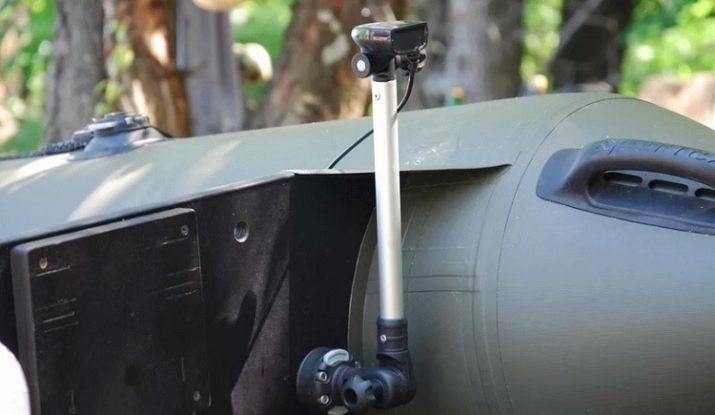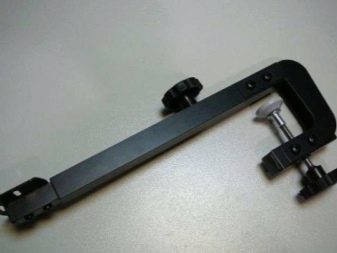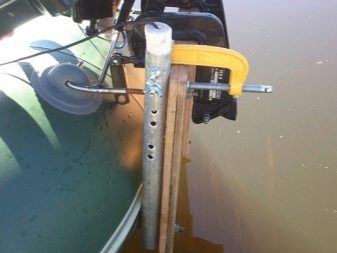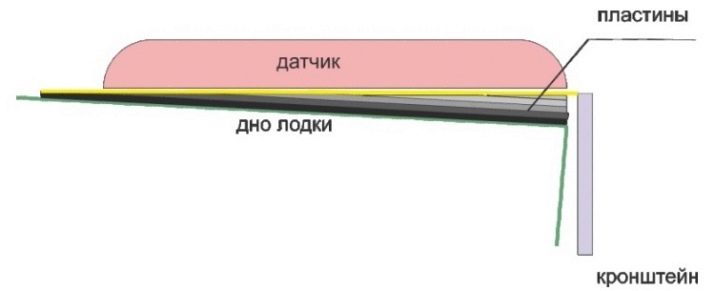How to choose and install an echo sounder on a PVC boat?

Today it is quite difficult to imagine fishing without an echo sounder (sonar). This device not only facilitates the whole process, but also makes it possible not to waste time on lack of fish.
What is it and why is it needed?
An echo sounder, or sonar, is a small device that can solve the problem of finding a fishing spot by signaling to its owner about the absence or presence of fish in this area. Device features.
- Determines the distance from the surface to the bottom. Large individuals stably stay near the bottom, which means that choosing the right spinning parameters or choosing the ideal mass of bait is the key to successful fishing.
- Shows the structure of the bottom surface. This is especially important when catching predatory inhabitants of the reservoir. By understanding the habits of the fish, one can easily determine its location.
- Shows concentration zones, fish size. This makes it much easier to choose the right place to cast.
- The temperature and phenomena formed in the atmosphere are constantly under control. The activity of the inhabitants of the reservoir mainly depends on these moments.
- GPS option. It helps a lot when visiting a large body of water.A good place is marked on the map, the device saves the location.


Popular Models
Sometimes even high-class fishermen barely understand how to pick up sonar for fishing from a boat. In order to make the task easier, it makes sense to look at the rating of the best modifications that have many excellent reviews and are in demand by buyers.
- Humminbird 561x. A budget device that has good performance and can become a good tool for a young fisherman. The principle of operation is based on a 2-beam system, which productively explores the depth and structure of the bottom surface, transmitting the data obtained to a high-quality 5-inch screen. Noticing promising prey, the device instantly signals this to the fisherman. Additionally, the modification has a sensor (sensor) for detecting water temperature, which is important for more effective fishing.
- Lowrance HDS. It is a more advanced gadget with a wide range of features, a durable case and a commensurate cost. In its segment, the device is considered the undisputed leader, in this regard, it is of interest to many fishermen, by the way, not only beginners, but also experienced ones.
- Humminbird 570 x D.I. This is a continuation of the 561x modification with more advanced options and an impressive screen size.
- FB 120x Humminbird. It is a special type of tube devices, which stands out among the prototypes by the possibility of functioning in two modes: normal and combined. In the first variant, one beam is involved in the work, and in the second, a side view functions additionally.
- Humminbird 798cxiHDSI Combo. Worthy of special attention when buying a sonar for fishing from a PVC boat.Along with a wide range of features, a powerful transmitter and increased sensitivity, this device is equipped with a durable housing and a large screen. Moreover, it uses the latest achievements, a reinforced processor and connectors for connecting external flash cards, the device supports the synchronization function with other sonars.
- Humminbird 597cxiHDDI Combo. For a long time, the sample was considered the best sonar for fishing from a PVC boat with a motor.
However, it has been discontinued, so you can only buy a used product.


Holder types
All holders based on location are:
- transom;
- mortise;
- mortise with a turn;
- fixed directly to the bottom of the watercraft.



Transom
Mounting the transducer (sensor) of the sonar on the transom is especially often practiced by fishermen. Its main components.
- Clamp - designed to mount the device on the transom.
- Sliding rail – 2 profiles of square section, threaded one into the other. The immersion depth of the sensor is adjusted by changing the length of the rail.
- Sensor bracket at the end of the rail - designed to fix the sensor itself on the bracket.
- Mounts to the bottom of the boat.
A similar mount for a sonar transducer includes a corner or other bracket, through which the sensor is firmly fixed close to the bottom.


This method of installing the sensor is used exclusively for devices with considerable power: inexpensive modifications are not able to break through even the thin floor of a boat made of polyvinyl chloride with their own signal, and what can we say about the bottom of a cauldron or a boat made of aluminum.
By means of mortise impervious fasteners, the sensor cuts directly into the bottom. Due to the location, absolutely nothing will interfere with its work in the future - neither the flow from the ship's propulsor, nor the algae and debris clinging to it. Mortise swivel holders are a modernized mortise mount with the function of turning the transducer placed inside it by an angle of no more than 120. They are mounted in a similar way as mortise modifications.

Selection Guide
Before choosing and deciding to purchase any modification of the echo sounder, you need to know what their differences are and what circumstances affect the price of a particular product.
So, in sonar for a boat, it is required, first of all, to look at the following parameters:
- sensor power;
- the degree of sensitivity of the information receiver;
- screen parameters: size, saturation, backlight, resolution, etc.;
- productivity of the processor-converter;
- number of scanning beams;
- device cost.


In addition to the basic parameters, it is necessary to pay attention to the configuration of the device. The sonar may also have:
- built-in navigator;
- territory maps;
- side view sensors;
- thermal sensor;
- speed sensor;
- transom bracket for PVC or rubber boats, boats NDND;
- case or bag for transportation;
- possibility of use in winter.
In parallel with the main device, you can choose a stand (table) for the sonar.


Installation subtleties
Each device is equipped with a mounting system, in addition, you can choose a holder for yourself, as it is presented separately in stores. But our people are not accustomed to relying on the manufacturer, because there are a number of ways to make it with your own hands.
A common mount is a rigid transom mount using such structures.
- Clamp. As a rule, it is made of stainless steel with a rubber gasket, which makes it possible to tightly, reliably and correctly fix the device to the solid surface of the water craft.
- Bracket. A tube that allows you to adjust the transducer in depth, and in expensive samples and the angle of rotation.
- Attachment for the sensor. With this device, the transducer is pressed against the holder.


Procedure.
- The clamp is pressed closely against the transom. In the presence of a motor, the location of the product is chosen so as to eliminate discomfort when maneuvering. The place of fixation, as a rule, is transferred to the right side or to the left closer to the board.
- The transducer is rigidly fixed to the holder, descends to the required depth.
- The holder is pressed against the clamp by means of a special screw.
- Adjustment is made in depth and angle to the plane. To do this, the clamp is slightly loosened on the clamp and the bracket moves in the right direction. Then the whole structure is firmly fixed.
- The sonar display is placed on a bench or bottom. A method with a suction cup on a rubber balloon is allowed.

DIY mount
Method 1
It is much cheaper to make a device on your own. This will require:
- a simple metal-plastic pipe about a meter long;
- a stainless steel tube with a diameter slightly larger than a metal-plastic pipe;
- clamp;
- bolts and washers, rubber gaskets (you can take old bike tubes), clamps, cotter pin.


Order of operations.
- Using clamps and gaskets, we fix an iron pipe about 0.4 m in size to the clamp.
- We put metal-plastic inside, flatten its lower end.We drill 2 holes to fix the transducer with bolts, washers and nuts.
- The sensor is fixed, and the cord from it is pulled through the body of the tube.
- The clamp is mounted on the transom, and the length of the metal-plastic tube is set using a cotter pin and previously prepared holes.
- A display is fixed to the end of the metal-plastic tube sticking out from above by any suitable method.

Method 2
This technique will work for those who consistently operate the same boat. It consists in the capital gluing of the transducer mount into the body.
- Near the keel, all layers on the bottom are cleaned off, up to the outer one.
- Using epoxy, the transducer is glued to the surface. A thin layer of rubber will not be able to interfere with the normal operation of the sensor.
- The remaining area from the cutout is filled with epoxy.

Method 3
Moving the transducer out of the boat. Actions.
- With electrical tape or adhesive tape, the sensor is fixed to the middle of a plastic bottle with a capacity of 0.5 to a liter.
- The cord from the transducer is fixed on the neck with the same tool.
- The display is placed on the bench, a wire is connected to it.
- The bottle is filled with water until the desired transducer immersion depth is reached.
The method is suitable for ponds without backwaters or currents.


For information on how to install an echo sounder on a PVC boat, see the following video.




























